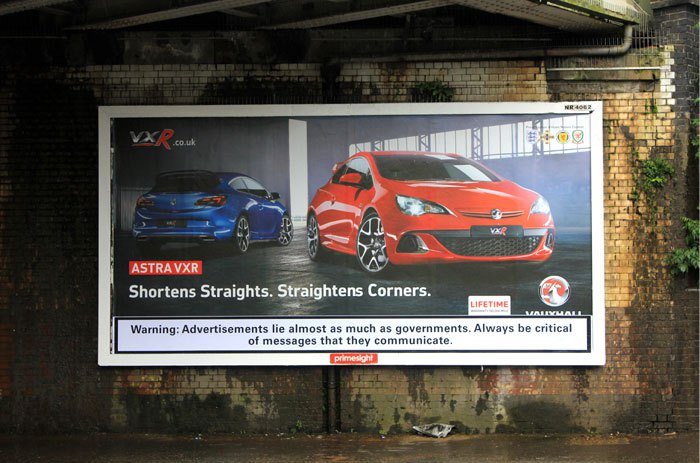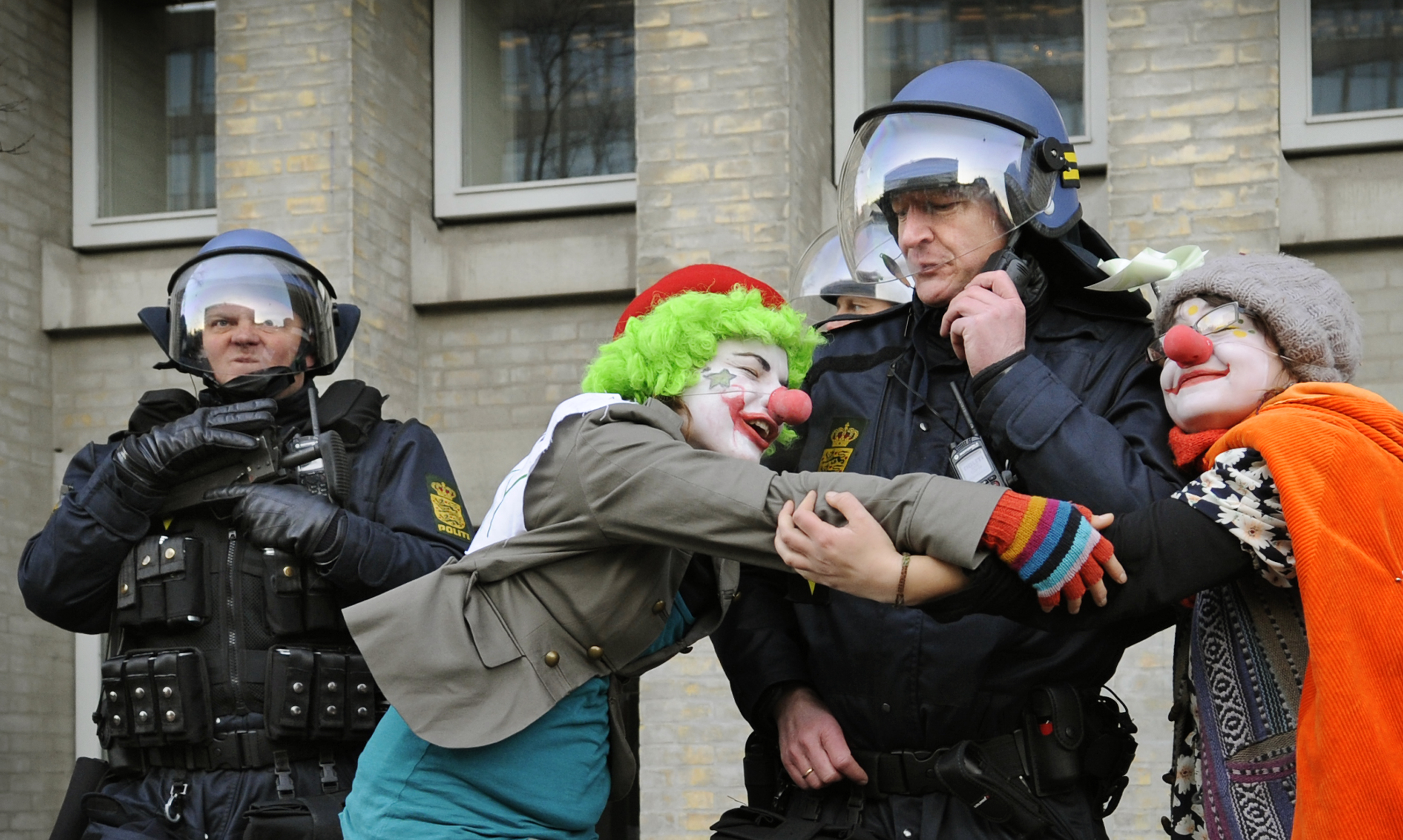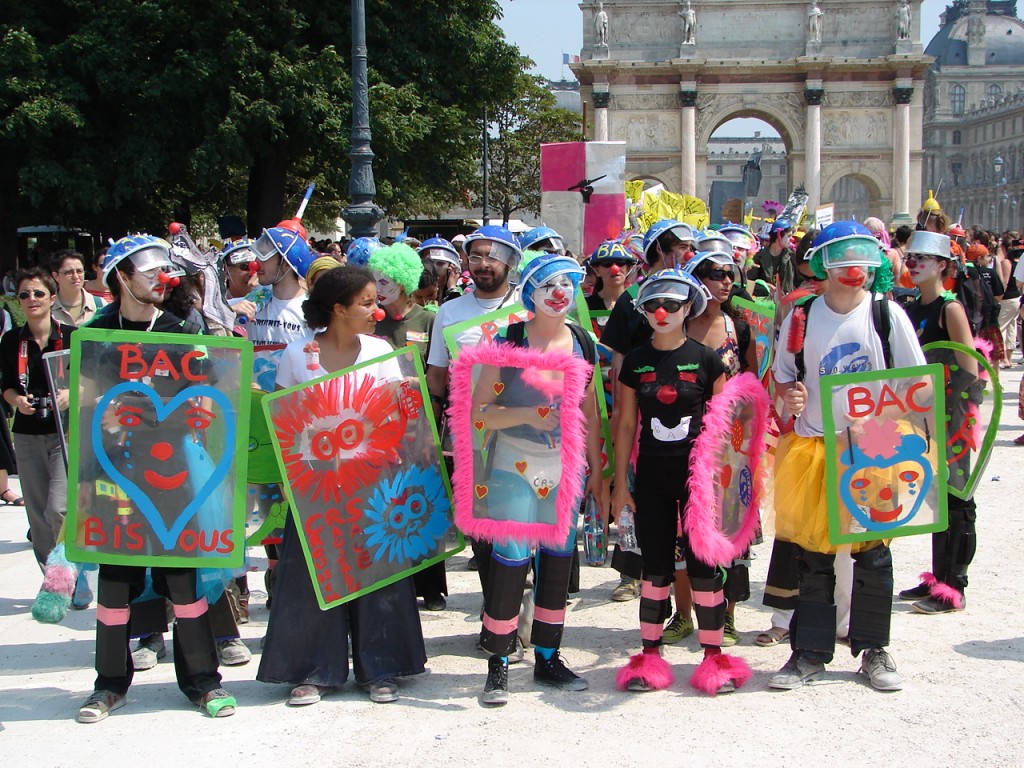What is protest? Vol.2 Subversialism
Subversialism
This is the second volume in a series of investigations into the concept of protest through examples and ideas.
In this essay we will be exploring three examples of protest which counter a certain hegemonic problem or power through some kind of subversion. We will find out that what makes these initiatives effective, is that they do not repeat the problem they are struggling against but that they use the main structures of these problems to expose that they are problems. They, so to say, colonialize the power they find problematic and therefore neutralise it: they turn it upside down, inside out. I call this process 'subversion' and its discourse 'subversialism'.
The three examples we will be looking at are ‘Brandalism’, the ‘Clandestine Insurgent Rebel Clown Army’ and ‘Rechts gegen Rechts’. Our aim is to find a common denominator within these three examples which we can call ‘subversialism’ – which we will then try to define.
1. Brandalism:
Marketing has been one of the most important aspects of contemporary capitalism. Yet it often is not straight forward and transparent. It does not just show you a product that you can buy. It shows you a product you must buy. It doesn’t just sell you the thing it offers, it sells you being a part of a society, a class, a hype or even of the species ‘human being’. The methods it uses are illusive. Marketing has long transcended the image of the product itself. It has occupied the list of ingredients on the back of your product as well as the images you see outside the clearly bordered domain of marketing print. It does not just place products in TV programmes, it designs TV programmes. It does not just promote products, it makes products. For many this is problematic. Marketing seems to occupy our public and private life. Sometimes it may even seem that we are not the individuals we would be without any marketing. Marketing has reached the domain of life itself.
Some protesters protest the whole notion of marketing, explicitly in public life. Yet there are also those who use the logics of marketing to show that it is elusive. They use it to broadcast a message that does not cohere with the typical economical messages marketing broadcasts, through the structures marketing uses.
One of the initiatives which employs this strategy is called ‘Brandalism’, which is a collaboration between artists that squat marketing space. From billboards alongside highways to posters in bus stops. They organise “creative action against ads as together we imagine a world beyond consumerism”.[1] The world they imagine is “emptied of mad empires, Manufactured fears, Paranoid dreams and marauded lands.”[2] So they “subvertise […] for hope, hope that is never too late to start.”[3] They want us to reclaim something that has always been ours, and through reclaiming, speak the ‘truth’ to power. This truth seems to be about autonomy, or rather its negation: to not be unconsciously influenced without consent.[4] They want to reclaim their own cognitive self-control through occupying the medium that colonialized it in the first place. The Guardian calls this ‘anti-advertising’,[5] which emphasises, through negation, that it is a form of advertising that is aimed against advertising. The Huffington Post praises Brandalism for the fact that they point out paradoxes, showing that what is said often does not cohere with what is meant or done.[6] Brandalism thus uses the same medium as the paradoxical problem they are opposing to show it is a paradoxical problem by using it for a different goal then marketing.
 Paul Insect (UK). 11019017470. Digital print. Manchester. http://brandalism.ch/artists/paul-insect-uk/
Paul Insect (UK). 11019017470. Digital print. Manchester. http://brandalism.ch/artists/paul-insect-uk/
 Ron English (US). Unicorn. Digital print. London. http://brandalism.ch/artists/ron-english-us/
Ron English (US). Unicorn. Digital print. London. http://brandalism.ch/artists/ron-english-us/
 Shift/Delete (UK). Manchester. http://brandalism.ch/artists/shiftdelete-uk/
Shift/Delete (UK). Manchester. http://brandalism.ch/artists/shiftdelete-uk/ 2. Clandestine Insurgent Rebel Clown Army:
Protest is often a place of antagonism. Protesters protest a problem that explicitly opposes their own ideas. This antagonism often crystallises when the ones in power assign the police to ‘restore order’. This often results in casualties: when those fall on the side of the protesters the police with face public criticism. When the casualties fall on the side of the police, the protesters will face not just public criticism but also official condemnation. This renders their ideas ‘dangerous’ and the actors of those ideas into ‘criminals’ or even ‘terrorists’. Violence is thus a very dangerous tool during protest, and yet protest often leads to violence. There are even some that argue that police use undercover agents to stir up the protesters so that police are given a reason to dismantle the protest and render the protesters’ ideas dangerous.
Protest, due to its antagonistic nature and the fact that tensions often rise very high, can be dangerous and rendered useless. To take control of these situations of high tensions is an act of strategy and tactic. One can use both to steer the protest in a certain direction, to pin point a transgressor, yet it can also be used to abolish the antagonistic situation between police and protesters. This cancels out the danger that the message of the protesters becomes illusive due to violence that they have used broadcasting it.
One of the initiatives that explicitly aims to turn this antagonistic situation of protest upside down is called the Clandestine Insurgent Rebel Clown Army (CIRCA), which is more of a tactic of protest then a centralised, organised group.[7] This army of ‘professional’ clowns use humour and laughter as a weapon against weapons. They perform their practise in the no man’s land between the protesters and the police. They make the police and protesters laugh, they illustrate the absurdness of the situation, or make it absurd. They say they are “clowns because what else can one be in such a stupid world” and “because a clown can survive everything and get away with anything.”[8] They say that “they aim[ed] to meet hate with love instead of meeting hate with hate.”[9] They don’t want to fight fire with fire, but with something that opposes it and ‘extinguishes’ it. They “make[ing] war with love”, stating that “nothing undermines authority like holding it up to ridicule”[10].
CIRCA offers its clowns a two-day training camp, in which clowns are educated with five ‘stages of clowning’.[11] This offers them hands on methods to clown effectively during protest. The first step is to go beyond viewing the site of protest as mere physical. “CIRCA sees both the soul and the street as sites of struggle, realising that a destructive tendency within many activist movement is forgetting the inner work of personal transformation and healing”[12] They want to show the ‘human’ – in the Levinasian sense – behind the protester and the police through the smile. Secondly, they transcend acting like a clown into clowning. This works because police are comfortable with confrontational resistance, as found in regular protest. They are not used to being “faced with the art of ridicule, they don’t know quite know how to respond”.[13] This also functions as a way of relativizing the tensions that are often present during protest.
 Adrian Dennis. climate protestors in Denmark. 2016. http://www.everydaysociologyblog.com/2016/04/play-and-public-space.html
Adrian Dennis. climate protestors in Denmark. 2016. http://www.everydaysociologyblog.com/2016/04/play-and-public-space.html
 Unknown. Hoping against hope, clowns ask for their toys back from Nice Mr. Policeman. London, 2003. http://beautifultrouble.org/case/clandestine-insurgent-rebel-clown-army/
Unknown. Hoping against hope, clowns ask for their toys back from Nice Mr. Policeman. London, 2003. http://beautifultrouble.org/case/clandestine-insurgent-rebel-clown-army/
 Unknown. http://mycours.es/gamedesign2014/gamify-everything/
Unknown. http://mycours.es/gamedesign2014/gamify-everything/
3. Rechts Gegen Rechts (Rights Agains Rights):
The third initiative occupies the space through which or in which a protest will take place. This gives contextual control over the protest itself. In this specific case, it is about a neo-Nazi march in a small German town – Wunsiedel – where a former Nazi official used to be buried. The local population faced this neo-Nazi memorial march with disgust every year until in 2014 they decided to take actions against it. They first tried forbidding the march through courts of justice, but despite the bans the marches continued. They thus had to find alternative tactics. So they, secretly, organised “Germany’s most involuntary walk-a-thon.”[14] For every meter the neo-Nazi’s walked 10 euros would be donated to an exit programme,[15] that helped neo-Nazi’s escape their ideology. The neo-Nazis thus campaigned against neo-Nazi’s. As a ‘motivation’, Rechts gegen Rechts replaced all the Nazi banners throughout the town with motivational slogans. Such as “If only the Führer knew” and “Quick like a greyhound! Tough like leather! And as generous as never before.”[16] Markings on the road updated the neo-Nazis on their progress and on how much money they had already collected.
Rechts gegen Rechts has effectively occupied and shaped the meaning of a protest which itself could not be stopped. By squatting the message that the neo-Nazis tried to broadcast, the meaning of the whole march had changed.
 Rechts gegen Rechts. "If only the
Führer knew" Wunsiedel. Photo. Germany. 2014. http://rechts-gegen-rechts.de
Rechts gegen Rechts. "If only the
Führer knew" Wunsiedel. Photo. Germany. 2014. http://rechts-gegen-rechts.de
 Rechts gegen Rechts. Left: "My mom. It's better to donate." Wunsiedel. Filmstill. Germany. 2014. http://rechts-gegen-rechts.de
Rechts gegen Rechts. Left: "My mom. It's better to donate." Wunsiedel. Filmstill. Germany. 2014. http://rechts-gegen-rechts.de

Rechts gegen Rechts. Left: "Donate every step, march on!" Right: "Rights against Rights" Right bottom: "Donate, march!" Wunsiedel. Filmstill. Germany. 2014. http://rechts-gegen-rechts.de
Subversialism:
All of the three examples given above share something in common. To be able to describe what that is we should first take a look at the word ‘subvert’. To subvert means to “undermine the power and authority of (an established system or institution)”[17] which stems from the Latin subvertere which means to “turn upside down”[18] which implies that the logic or method of doing of the established system or institution is being turned upside down: a negation of the problem. This result in a new perspective on something that might seem rigid or set in stone. This is a way of ‘absurdifying’ – making the normal the weird. Making the normal humorous. A second historical description from the word ‘subvert’ stems from the 14th century French and implies the goal of this turning upside down: “to raze, destroy, overthrow, undermine, overturn”[19]. The process of absurdifying is thus not the goal of subversion, it is to eventually overthrow the system or institution that is turned upside down.
When we
look at the three examples given above the role of humour becomes clear.
Firstly, because humour is a way of turning things upside down. It is a way of relativizing.
Secondly, things upside down are humorous because it, so to say, offers a peek
under the skirt of the problem. This is effective because it is not only funny
for the spectators (the Brandalist artists, the Clowns or the organisers of
Rechts gegen Rechts) but also for the subject of their activities. The moment
they start to laugh, and see how weirdly their logic functions, the system is ‘overthrown’.
It loses all its power, because power depends on people keeping it in place. When
the people keeping it in place see how weird the power is, it will lose its
power. This results in a neutralisation of the antagonism often encountered
between different protests groups and between those and the police. Executing
this process of humour through absurdification and turning things upside down
in regards to one specific problem is what we can call subversialism.
Written and published bij Eef Veldkamp, 06-01-2018.
[1] Anonymous. http://brandalism.ch. 2017. Website introduction tekst.
[2] Anonymous. Declaration; Manifesto. http://brandalism.ch/manifesto/. 2017.
[3] Ibid.
[4] Ibid. “We take this space back to speak truth to power, to oppression, to injustice, against those that would have us give our lives, our brightest years, of all that we are and could be to the serpent of consumption perpetuating a world we don’t believe in distracting us from each other in favour of ourselves, destroying our ability to think and fantasise wildly.”
[5] The Guardian. Anti-advertising: the hijacked bus stops of Paris – in pictures. London: The Guardian, 2015. https://www.theguardian.com/artanddesign/gallery/2015/nov/30/anti-advertising-the-hijacked-bus-stops....
[6] Tim Ward. Brandalism Campaign Points out Paradoxes of the Paris and Climate Conference. New York: The Huffington Post, 2015. https://www.huffingtonpost.com/tim-ward/brandalism-campaign-point_b_8680712.html
[7] Matthew Knauf, Mark Simpson, KT Bender and Jamie Posner. Weapons of Laugh Destruction: The Geographical, Political, and Theoretical Roots of Clowning Protest in Tokyo. Los Angelos: University of California, 2013. http://www.urbanhumanities.ucla.edu/wp-content/uploads/FA13-Weapons-of-Laugh-Destruction.pdf. 4.
[8] Ibid., 7.
[9] Ibid., 4.
[10] Ibid., 5.
[11] Ibid.
[12] Ibid.
[13] Ibid., 6.
[14] Nazis Against Nazis – Germany's Most Involuntary Charity Walk. 2014. Online video. Youtube: Rechts gegen Rechts. https://www.youtube.com/watch?time_continue=40&v=KvjIYl_Nlao.
[15] See: Exit Deutschland. http://www.exit-deutschland.de.
[16] Ibid.
[17] "subvert". 2017. Oxford Dictionaries. Oxford: Oxford University Press. https://en.oxforddictionaries.com/definition/subvert.
[18] Harper, Douglas. 2017. "subvert". Online Etymology Dictionary. Lancaster: Douglas Harper. https://www.etymonline.com/word/subvert.
[19] Harper, Douglas. 2017. "subvert". Online Etymology Dictionary. Lancaster: Douglas Harper. https://www.etymonline.com/word/subvert.

